Lifestyle
Needing a break from L.A., artists turn a cabin near Joshua Tree into a family escape
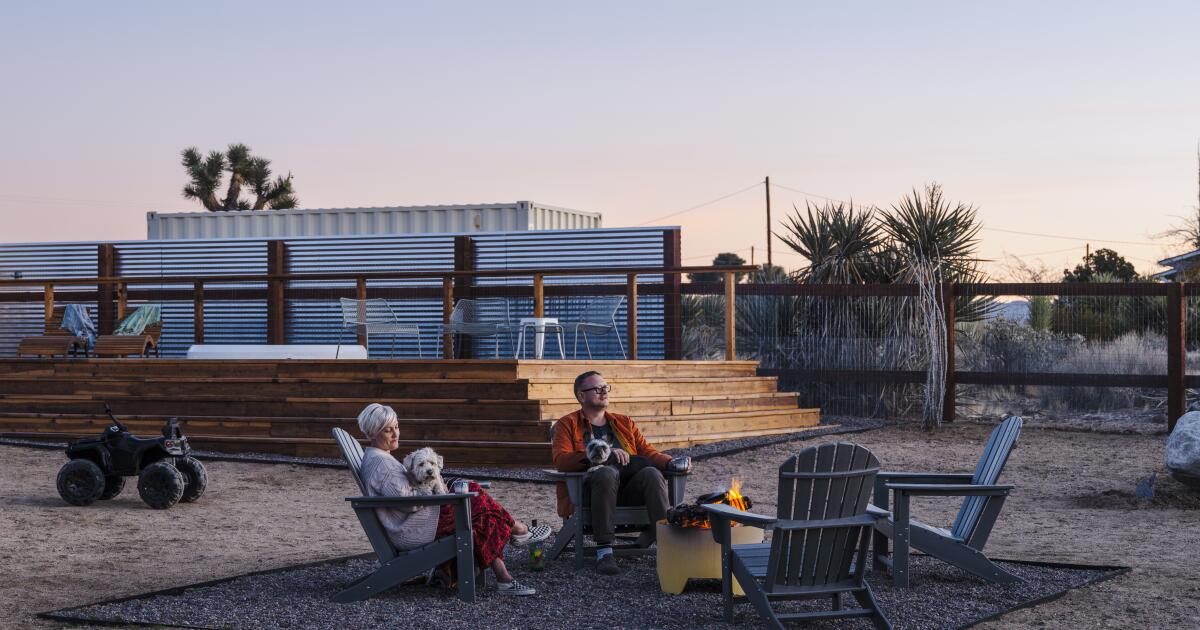
On a sunny spring afternoon in the high desert, Adam Miller and Devon Oder prepared to welcome guests — friends, neighbors, artists and family members — to a reception for artist B. Wurtz at their one-bedroom cabin in Yucca Valley.
Like many Los Angeles parents of young children who needed a break during the COVID-19 pandemic, the married artists and gallerists escaped to Yucca Valley with their two sons and three rescue dogs amid stay-at-home orders.
Oder, a Los Angeles native who first camped in Joshua Tree when she was a student at UC Santa Cruz, says they had long dreamed of buying a home in the desert. “Spending more time here during the pandemic reinvigorated our dream,” she says.
When a local real estate agent specializing in off-market listings showed them a tiny cabin on 2½ acres above downtown Yucca Valley, their dream of purchasing a home and living part-time in the desert became a reality.
The sunken living room features a colorful oil painting by Joani Tremblay, a ceramic owl by Myungjin Kim and a large ceramic vessel by Jennifer Rochlin.
(Lance Gerber)
“Once we opened a second gallery in Palm Springs, we wanted to be immersed in the community here,” says Miller. “We dreamed of buying land and building our own home, but once we found this cabin, we knew we wanted to start living here right away and make memories with our children.”
Today, the 1958 cabin is more than just a second home for the Pit art gallery owners who met while getting their MFAs at ArtCenter College of Design in Pasadena and later worked as studio assistants for Los Angeles artist Sterling Ruby. It’s also a place where they can connect with a thriving community of artists, such as their neighbor Heidi Schwegler of the Yucca Valley Material Lab and Ryan Schneider and Heather Day, whom they represent at the Pit.
“They made a decision to become a part of the community here,” says Schneider, an artist primarily focused on sculpture who lives in Joshua Tree full time. “They renovated the cabin in a beautiful way, filled it with art and started hosting gatherings. It has a super warm, family vibe.”
When Miller and Oder first saw the house on a scouting trip, Oder says she “immediately said yes.” Although the house was offered as is in a probate sale, they could tell that the previous owner, a musician who had died, had taken care of it. “The property just needed some love,” she says.

“The property just needed some love,” says Oder of the 1958 cabin, shown before it was remodeled.
(Devon Oder)
Miller wasn’t as certain.
“The house wasn’t a teardown, but it was gnarly,” he says of the dark wood-paneled walls and small, compartmentalized rooms.
Still, the simple kitchen and Home Depot bathroom were functional. A detached garage would help with storage since the cabin had no closets. The plumbing and the existing mini-split HVAC system were in good shape. But with the cabin measuring 988 square feet, the couple wondered where everyone would sleep.
Uneven floor slabs hinted at minor additions over the years, including a supply room with shelving off the lone bedroom and bath. “I thought, ‘If we can fit a bunk bed in the pantry for the boys, then we should buy the house,’” Oder recalls with a laugh. Her optimism prevailed. Logan, 5, and River, 8, now sleep in bunk beds in the tiny space. They also added a pullout sofa in the living room and RV hookups in the backyard, hoping to accommodate more friends and family.

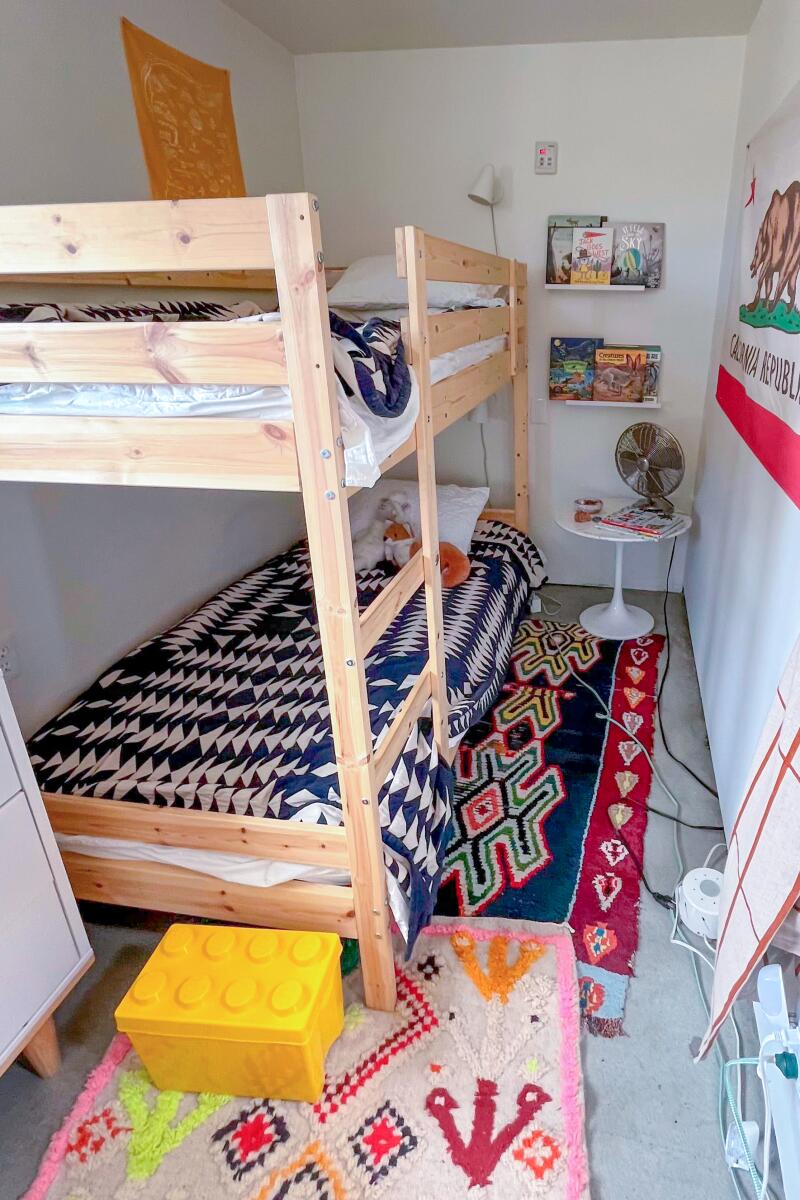
The pantry of the Yucca Valley cabin before it was turned into a room for the kids, shown right. (Devon Oder) The former pantry today. (Lisa Boone / Los Angeles Times)
In 2022, the desert contractors they approached were busy with remodeling projects, so the couple hired a gallery associate in Los Angeles who moved into the house and completed a cosmetic makeover in just a month and a half with the assistance of three others with remodeling experience .
Rather than completely redoing the interiors, the couple kept as much of the cabin’s original charm as possible, including the 1960s oven and stove in the kitchen, windows, a wood-burning stove in a brick-backed corner of the dining room and some wood paneling. “We wanted it to feel like a cabin,” Miller says. “But we wanted it to feel homey too.”
The sunny transformation in the kitchen includes new butcher block countertops and open shelves filled with Miller’s Reaperware ceramic dishes. More handmade tiles by Miller, who is also a painter, brighten the backsplash behind the sink and stove. The couple also chose to preserve the funky kitchen island — a walnut dresser with drawers; they freshened it up with a new butcher block countertop to match the others.
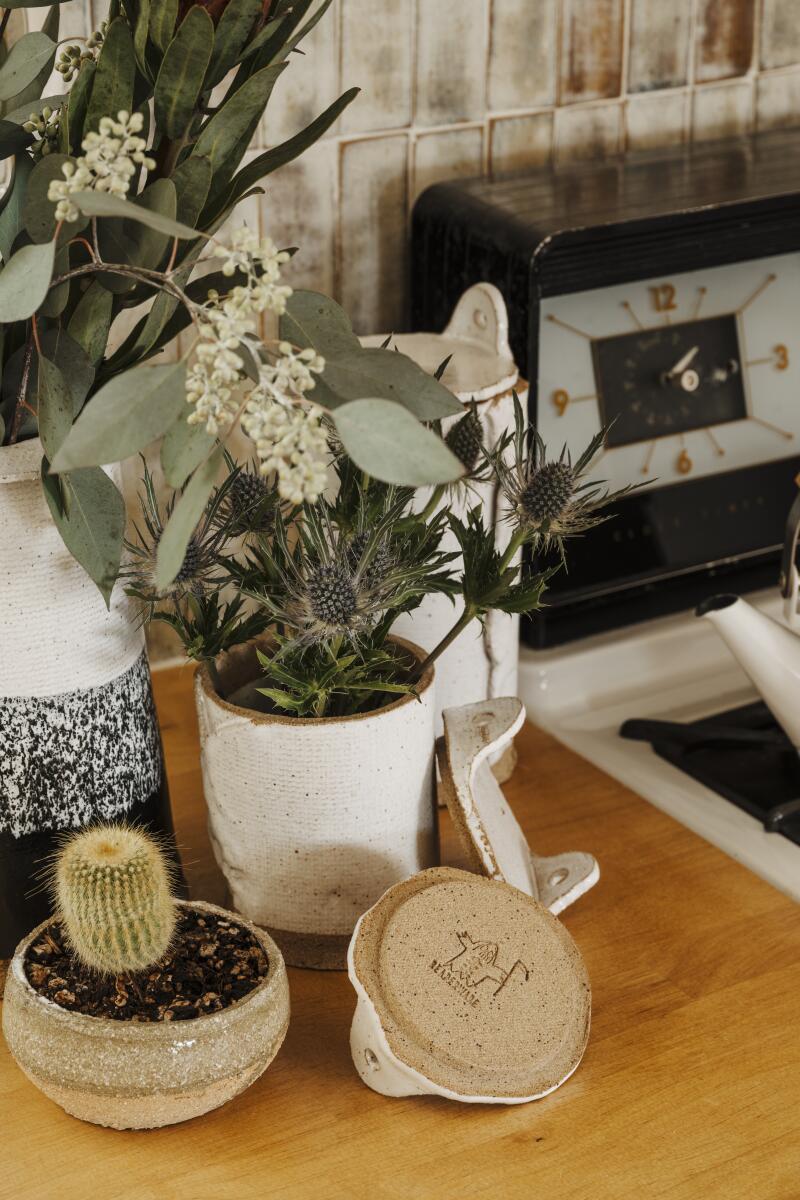
(Lance Gerber)
The wall that once separated the living room from the kitchen and dining area was removed to open up the interiors, and the concrete floors, which had several layers of paint, were ground down and repolished — a no-nonsense move that suited the family’s indoor-outdoor lifestyle.
To add further warmth to the interiors, the couple — who are both 42 — combined colorful Moroccan rugs with cotton kilims and textiles, including double-sided handmade cotton and linen drapes that Miller’s mother sewed using Marimekko fabric.
And then there’s the art, which Miller says was chosen because it “felt appropriate for the desert environment,” including mixed-media pieces and ceramics by Miller and Oder, George Sherman, Joani Tremblay, Tony Marsh and Jonathan Cross.
After the couple updated the interiors, which cost around $45,000, not including furniture, fixtures and appliances, they focused on the outdoor area, which was mostly unkempt with bricks, trash, random planters and a run-down shed. A propane tank in the middle of the yard was relocated, and the couple hopes to turn a shipping container left behind into an art space.
Working together, they installed new cactuses, succulents, boulders, a hot tub and a galvanized steel cowboy tub for their boys.
When they wanted to add a redwood deck, the artists drew it on a piece of white paper and asked Los Angeles-based contractor Finished by Design to build it. A firepit and a shady pergola create more places for the family and their guests to congregate outdoors when the weather’s right. Temperatures can reach triple digits in the summer, and it’s been known to snow in the winter.
Because they have dogs and kids, Oder and Miller had a three-foot-deep rattlesnake fence installed around the property’s perimeter. So far, they haven’t seen any snakes, but their neighbors warn them they are out there. According to Oder, the backyard, which features uninterrupted mesa views, is now “the best part” of their property.
After living in Joshua Tree for a decade, Schneider appreciates the couple’s landscape choices. “You are dealing with so many elements out here,” he says. “They did it right: practical but beautiful. You must do that when living in Joshua Tree, Yucca Valley and Twentynine Palms. It should be as simple as possible so that you can enjoy the mountains, hills and desert landscape.”
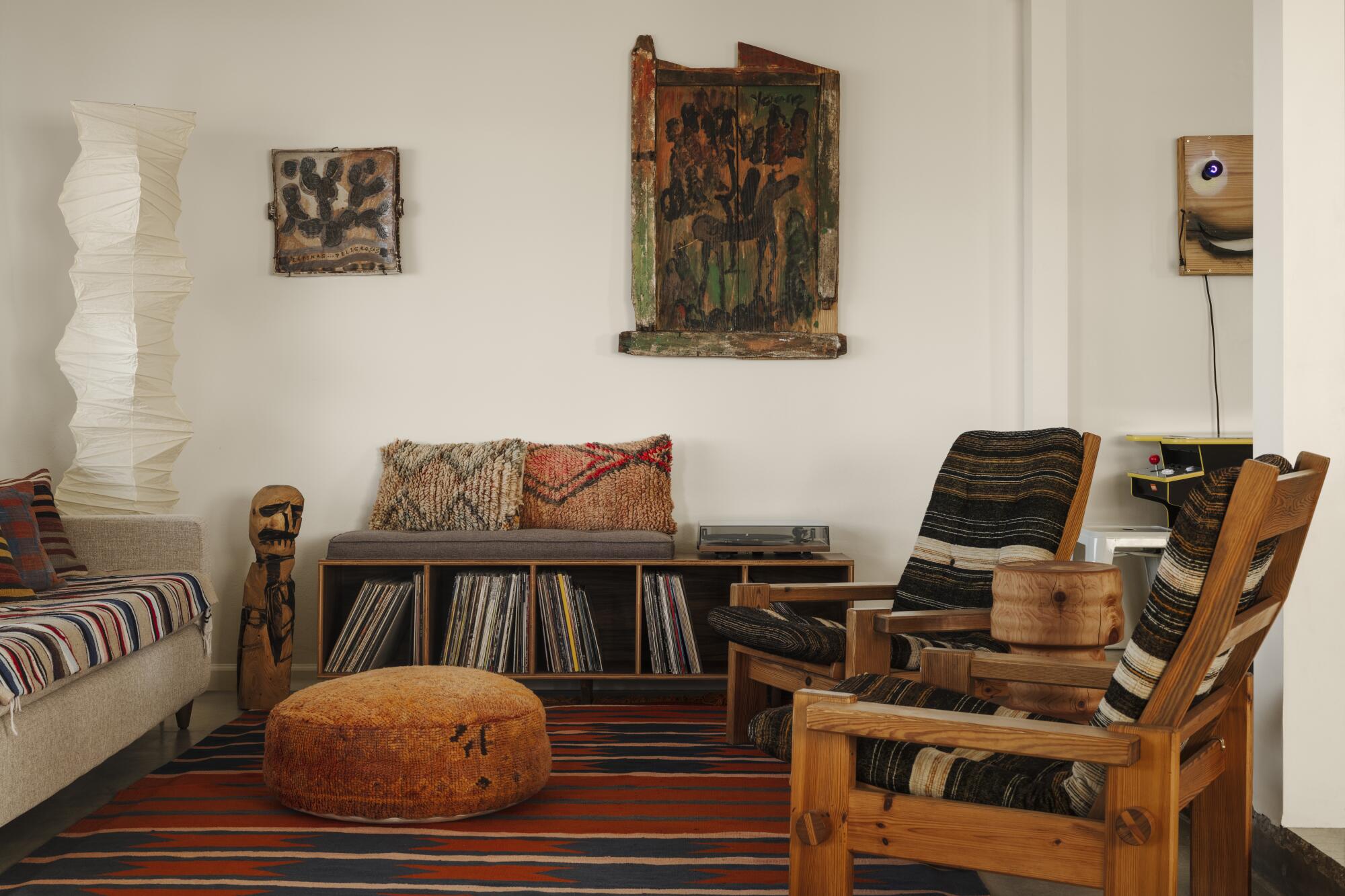
The living room includes a wooden skeleton sculpture by Ryan Schneider, left, a ceramic tray by George Sherman, above left and a painting on wood by Purvis Young.
(Lance Gerber)
It may be surprising that Miller and Oder, whose primary residence is a Spanish-style home in Eagle Rock, live in a modest cabin on a remote dirt road.
But sit with them on their outdoor deck, where you might catch a magnificent sunset, and you’ll find a couple deeply appreciative of their surroundings.
“It’s a wonderful place to unplug,” Miller says. “The environment is so tranquil that it feels like a mental shift. Our careers are so busy. We wanted a place to be in nature and focus on our family.”
When in town, the family enjoys visiting nearby Pioneertown, Joshua Tree National Park and Noah Purifoy’s outdoor sculpture. “The boys like seeing that you can make art with discarded toilets,” Oder says. But mostly, they love hanging out at the cabin, where they can soak, play, drive their battery-operated ATVs around the backyard and make s’mores at the outdoor firepit. “All the things we don’t let them do at home,” notes Oder.
Adds Miller: “It’s like a breath of fresh air here. It often takes a while to decompress, but after a couple of days, we don’t want to leave.”
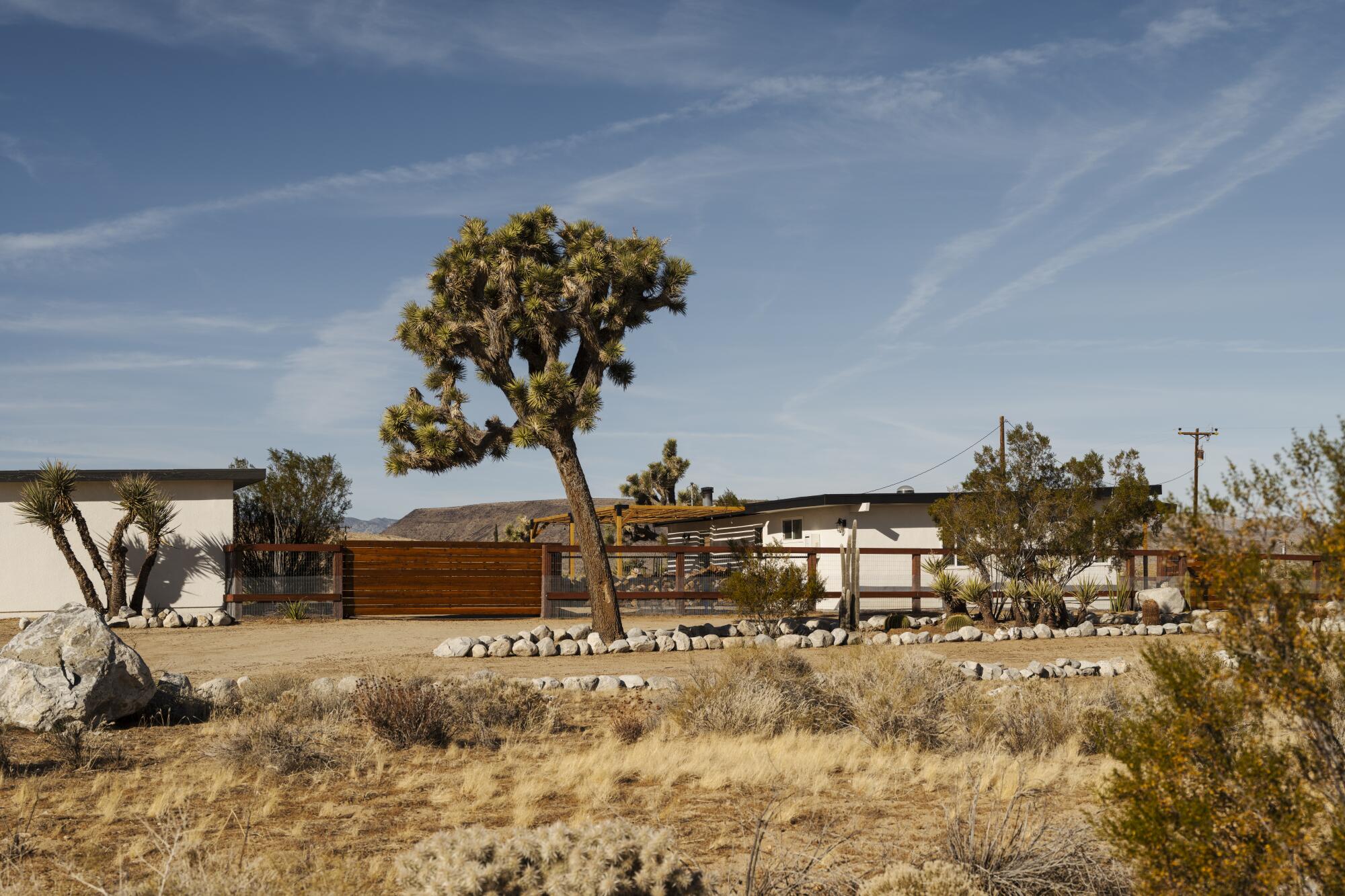
A view of the one-bedroom cabin off a dirt road in Yucca Valley.
(Lance Gerber)

Lifestyle
What does 'The Bear' restaurant review say? We take our best guess

Jeremy Allen White as Carmy Berzatto.
FX
hide caption
toggle caption
FX
Haven’t watched the season finale of The Bear yet? Then you probably don’t want to read this. Don’t blame us for spoilers.
So what does that review say?
At the end of the third season of The Bear, Carmy (Jeremy Allen White) looks at his phone late one night and sees a review of his new restaurant, The Bear, in the Chicago Tribune. All we see are flashes of words and phrases, some seemingly good and some seemingly bad, and then Carmy says, “mother——,” and that’s the season.
And look: The idea is to leave you uncertain about what the review says, and to be clear, the review could say a lot of things. Trying to decode the words we can see and come up with an idea of whether this is a good or a bad review is rank speculation. Rank, I say! So let’s speculate.
I’m really not excited to reveal how long I spent doing this, but what I am about to show you is the best rendering I can manage of the words (and parts of words) that they show in this little sequence. I present them in the form of a poem, since I can’t offer you screenshots. (These groups of words, of course, are undoubtedly not in this order in the actual review. And yes, I think this is a show that’s probably playing fair; I think these probably are all consistent with the actual review that we will eventually learn much more about.)


of flavors both d
the confusing mis
any apprehension
an almost sloppy fas
f innovative d
nu was a testa
complex array
, as each dish arrived, there
were excellent, sho
rt, leaving me fee
focus on pushing
true culinary gem
my experience at
tto, offering a
palpable dissonance b
ng the chef’s brilliant cr
disappointed and craving
Feeling disapp
and downs, t
inconsistent
as resting on
undeniable inco
of delicious pe
tchen couldn’t
e. However,
was simple an
s the potential
Berzatto p
s not subtract f
felt overdone
incredible
Carmen Berzatto

re tired a
t stale a
talent
Clear as day, right?
For my money, the most interesting phrase comes from the screen that highlights the word “delicious.” Below that, you can see “tchen couldn’t.” My guess is that the full review uses the words “kitchen couldn’t.” And I’m going to further guess that “undeniable inco” is part of something like “undeniable inconsistency” or “undeniable incompleteness” — in other words, something negative. And in the middle, the word “delicious.”
So: what if the review is basically saying that there is an inconsistency in the operation because the kitchen isn’t doing a solid enough job?
That would also fit with this bit right here:
tto, offering a
palpable dissonance b
ng the chef’s brilliant cr
disappointed and craving
Feeling disapp
Now, the “tto” is probably the end of Carmy’s name (although I suppose a word like “risotto” is possible). But right in the middle, you have “the chef’s brilliant cr,” which might be “the chef’s brilliant creations” or “the chef’s brilliant creativity” or something like that. And before that, you have “dissonance.” And after it, “disappointed.” Again, what if this is saying Carmy is a brilliant genius, but something is amiss in the staffing and the execution?
Could this also be what “an almost sloppy fas” is about? What if that says the dining room — Richie’s beloved dining room — operates in an almost sloppy fashion? It also occurred to me that it could be a reference to The Beef, that The Beef was “almost sloppy fast food” or something. Or perhaps Neil Fak is a little too sloppy for this reviewer’s refined tastes.
Here’s another interesting part:
f innovative d
nu was a testa
complex array
That middle line should be “menu was a testament,” right? The menu is a testament to something? Probably Carmy’s brilliance? The changing menu he’s been obsessed with? And that would fit with “f innovative d,” which could be, say, “of innovative dishes.”
A prediction
Go back and read it all, like a poem, all together, and let it wash over you. Here’s what I think the review might say: Carmy is an amazing chef, full of potential, creative and amazing. But the rest of the team is not living up to his great ideas. In other words, I think the review says everybody else at The Bear needs to get on Carmy’s level.
If it says that, then that would explain why, after reading a review that (probably) calls him “brilliant,” he swears angrily. It would also complicate his obsession with his own standards to see the system he insisted on (the changing menu especially) wind up making him look good, but interfering so much with how the place runs that other people look bad.
I want to stress that if this is all completely and totally wrong, it will be no surprise. The whole thing could be a misdirect, every word could be misleading — “the chef” might not be Carmy, “nu” could be “Keanu” instead of “menu,” you get the idea.
But to me, it would be consistent with this season if Carmy had the most pyrrhic of pyrrhic victories, and this review gave him what he wanted at the expense of the people he works with.
Lifestyle
Seoul to create national symbol space with giant Taegeukgi

Lifestyle
Jury orders NFL to pay billions in 'Sunday Ticket' case for violating antitrust laws

NFL Commissioner Roger Goodell is shown arriving at federal court June 17, 2024, in Los Angeles.
Damian Dovarganes/AP/AP
hide caption
toggle caption
Damian Dovarganes/AP/AP
LOS ANGELES — A jury in U.S. District Court ordered the NFL to pay nearly $4.8 billion in damages Thursday after ruling that the league violated antitrust laws in distributing out-of-market Sunday afternoon games on a premium subscription service.
The jury awarded $4.7 billion in damages to the residential class and $96 million in damages to the commercial class. Since damages can be tripled under federal antitrust laws, the NFL could end up being liable for $14.39 billion.
The lawsuit covered 2.4 million residential subscribers and 48,000 businesses in the United States who paid for the package of out-of-market games from the 2011 through 2022 seasons on DirecTV. The lawsuit claimed the league broke antitrust laws by selling its package of Sunday games at an inflated price. The subscribers also say the league restricted competition by offering “Sunday Ticket” only on a satellite provider.
The NFL said it would appeal the verdict. That appeal would go to the 9th Circuit Court of Appeals and then possibly the Supreme Court.
Should the NFL end up paying damages, it could cost each of the 32 teams approximately $449.6 million.
“We are disappointed with the jury’s verdict today in the NFL Sunday Ticket class action lawsuit,” the league said in a statement. “We continue to believe that our media distribution strategy, which features all NFL games broadcast on free over-the-air television in the markets of the participating teams and national distribution of our most popular games, supplemented by many additional choices including RedZone, Sunday Ticket and NFL+, is by far the most fan friendly distribution model in all of sports and entertainment.
“We will certainly contest this decision as we believe that the class action claims in this case are baseless and without merit.”
The trial lasted three weeks and featured testimony from NFL Commissioner Roger Goodell and Dallas Cowboys owner Jerry Jones.
“Justice was done. The verdict upholds protection for the consumers in our class. It was a great day for consumers,” plaintiffs attorney Bill Carmody said.
During his closing remarks, Carmody showed an April, 2017, NFL memo that showed the league was exploring a world without “Sunday Ticket” in 2017, where cable channels would air Sunday afternoon out-of-market games not shown on Fox or CBS.
The jury of five men and three women deliberated for nearly five hours before reaching its decision.
Judge Philip S. Gutierrez is scheduled to hear post-trial motions on July 31, including the NFL’s request to have him rule in favor of the league because the judge determined the plaintiffs did not prove their case.

Payment of damages, any changes to the “Sunday Ticket” package and/or the ways the NFL carries its Sunday afternoon games would be stayed until all appeals have been concluded.
The league maintained it had the right to sell “Sunday Ticket” under its antitrust exemption for broadcasting. The plaintiffs said that only covers over-the-air broadcasts and not pay TV.
Other professional sports leagues were also keeping an eye on this case since they also offer out-of-market packages. A major difference though is that MLB, the NBA and the NHL market their packages on multiple distributors and share in the revenue per subscriber instead of receiving an outright rights fee.
DirecTV had “Sunday Ticket” from its inception in 1994 through 2022. The league signed a seven-year deal with Google’s YouTube TV that began with the 2023 season.
The lawsuit was originally filed in 2015 by the Mucky Duck sports bar in San Francisco but was dismissed in 2017. Two years later, the 9th Circuit, which has jurisdiction over California and eight other states, reinstated the case. Gutierrez ruled last year the case could proceed as a class action.
-

 News1 week ago
News1 week agoNYC pastor is sentenced to 9 years for fraud, including taking a single mom's $90,000
-

 News1 week ago
News1 week agoRead the Ruling by the Virginia Court of Appeals
-

 News1 week ago
News1 week agoTracking a Single Day at the National Domestic Violence Hotline
-

 World1 week ago
World1 week agoOrbán ally-turned-rival joins EPP group in European Parliament
-

 Politics1 week ago
Politics1 week agoTrump classified docs judge to weigh alleged 'unlawful' appointment of Special Counsel Jack Smith
-

 News1 week ago
News1 week agoSupreme Court upholds law barring domestic abusers from owning guns in major Second Amendment ruling | CNN Politics
-

 Politics1 week ago
Politics1 week agoSupreme Court upholds federal gun ban for those under domestic violence restraining orders
-

 Fitness1 week ago
Fitness1 week agoWhat's the Least Amount of Exercise I Can Get Away With?

















